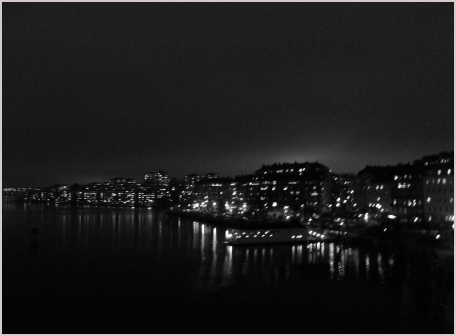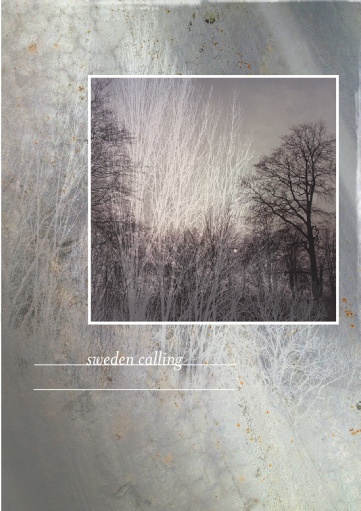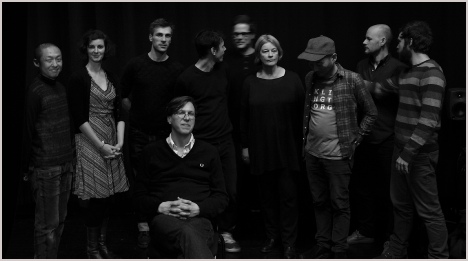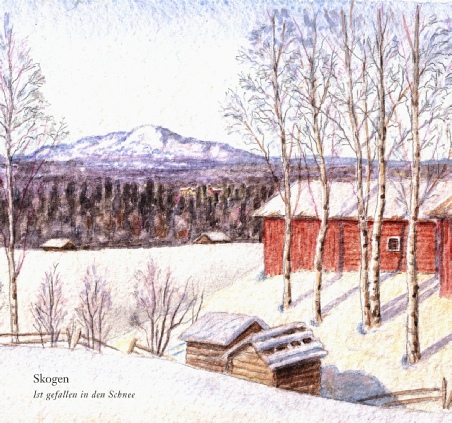Another Timbre TimHarrisonbre
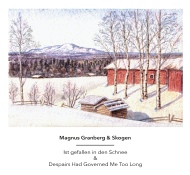
at4771 Magnus Granberg & Skogen
‘Ist gefallen in den Schnee’ (2010)
& ‘Despairs Had Govered Me Too Long’ (2012)
2017 double CD re-issue of two single CDs which had sold out
Magnus Granberg - piano Angharad Davies - violin Leo Svensson Sander- cello
Erik Carlsson - percussion John Eriksson - vibraphone & crotales Petter Wästberg - electronics Henrik Olsson - bowls and glasses Anna Lindal - violin Toshimaru Nakamura - no input mixing board Ko Ishikawa - sho (‘Despairs…’ only)
Recorded November 2010 and November 2012 in Stockholm
youtube extract (Ist gefallen…) youtube extract (‘Despairs…’)
Interview with Magnus Granberg
on release of ‘Ist gefallen in den Schnee’ (2010)
First of all where do the ideas for the piece come from? I know that Schubert was important in some way, but don’t know how. Could you explain this?
The way the piece relates to Schubert is that the rhythmic material as well some other temporal proportions are derived from two different songs from Schubert's well known (well, that's an obvious understatement!) song cycle Die Winterreise; the title of the piece,
Ist gefallen in den Schnee, is a text fragment derived from one of these songs.
The tonal material, on the other hand, is derived from a jazz song, which one I have actually forgotten. The rhythmic as well as the
tonal material is then transformed by means of different methods, in some cases rather mildly, in other cases rather heavily.
So, why did I choose to do like this when writing the piece? For a couple of different reasons, I think. For me it's a very concrete way of relating to and at the same time transcending musics that have, in one way or the other, been of a certain importance to me. Coming more or less from a working class background as I do, choosing Schubert is a way to approach a music that I haven't really have had access to (but which I somehow have come to like), without giving in to it fully. Jazz, on the other hand, is more or less what I grew up listening to, so partially basing the piece on a jazz song is a simple way to relate to that heritage without reproducing the actual music. It's obviously also a (perhaps both naïve and pretentious) way of trying try to reconcile musics with different social connotations, and a way to reconcile oneself with history and the contemporary world.
That’s interesting because listening to it without knowing this, I don’t think of either Schubert or jazz. The music it reminds me of most is Feldman – though obviously as a kind of improvised or semi-improvised re-working of Feldman’s sound. Can you explain to what extent the piece was composed or improvised, and whether Feldman is in there at all?
Yes, it's more or less impossible to identify the source material, the Schubert songs and the jazz music are very much to be found in the subtexts, but in a very concrete way, though. The musics and ideas of the composers associated with the so called New York School have, among many other things, also been very influential and dear to me. The early music of Morton Feldman was probably the first modern classical music I could thoroughly relate to when I first heard it in my late teens; it seemed informal and at the same time very much open to the outside world, even more so than Cage's music, which I of course still love as well!
Regarding the piece on the record, it is an attempt to thoroughly integrate composition and improvisation. In my role as a composer I provide different pools of material (pitches, rhythms, timbres, melodic fragments, chords etc), suggestions regarding how to treat the material and a temporal structure which regulates which pool of material should be used when. Perhaps one could say that I provide a potential which could be realized in innumerable ways, but the actual realizations are always the result of what decisions the musicians make throughout the piece; formal differentiation occurs spontaneously as a result of an improvisational process.
Duration is another aspect of the piece that reminded me of Feldman. It’s unusual to have a single movement piece, whether composed or improvised, that lasts over an hour. And for me there’s a similar sense as in Feldman of hearing patterns slowly unfold rather than having dramatic changes or developments across the piece. Is duration a factor that you were consciously addressing?
Well, duration is quite an important factor in our music in that it allows certain things to happen or potentials to be realised that probably wouldn't occur within a shorter time span. The totality of all different factors constituting the music at the particular time when playing and/or listening is to me mainly a sense of spatiality, though: everything which takes place or even that could take place but actually does not during that particular time are all part of that experience. When I first formed Skogen (which is Swedish and translates as “The Forest” or The Woods”) I also had a feeling and an idea that the music should be like an environment, perhaps a forest in which inhabitants with different characteristics could move freely in accordance with the environment and their own and each other's properties and abilities; the piece, the time and the space could be the forest and the musicians its inhabitants.
Yes, I was going to ask what Skogen meant. The ‘environment’ of the group on this occasion involves several Swedish musicians, but also Toshi Nakamura and Angharad Davies. How did this come about – and is the Swedish core of the group consistent, or do different musicians come and go within that as well?
I had known and admired Toshi's work since the beginning of the 2000s, and Erik and Henrik (the two percussionists in Skogen) had also made a tour of Sweden in 2008 together with Toshi and Tetuzi Akiyama, so there was already some sort of connection there. The first time I heard Angharad must have been on the album Endspace together with Tisha Mukarji, which was released on your label. I had also heard some marvellous solo violin pieces that thoroughly convinced me that Angharad's playing would fit very well with the ensemble, so I simply asked her to join us. The core of the ensemble has so far consisted of five Swedish musicians, but on this occasion was enlarged with the addition of another two wonderful Swedish musicians - violinist Anna Lindal and vibraphone player John Eriksson – and will continue as an ensemble of nine in the future.
I listened to the disc again today, and it struck me that although the dominant feel of the piece is one of beauty, at times different players – perhaps especially Toshi Nakamura and Petter Wästberg – are gently pushing against that and playing a subversive role. That tension between an almost static beauty, and an energy that pushes the music along really works for me. As the composer, do you see it like this at all?
I think that's a correct observation, the roles of Petter and Toshi are very free indeed. They were provided with some suggestions and some rather vague materials that they could choose to relate to if they wanted to, but their primary function is one of free improvisation. Apart from that, all players are provided with more or less specified materials and suggestions on how to treat them and are also encouraged to choose how much they would like to adhere to them and how and when to deviate from them. The players all make different choices at different times, all in accordance with their personal inclinations as well as how the music is shaped through the dynamics of group improvisation. I myself, for example, mostly tend to limit the elements of improvisation to what material is played when, how many times the materials are repeated, how notes are accentuated, minor changes in tempo, slight fragmentations and permutations of the materials et cetera. Other players obviously and happily make other choices, which makes the music come alive in ways I wouldn't have been able to come up with myself. To take part in how something rather well known is transcended and transformed into something previously unknown is a blissful and rewarding experience quite central to how and why I choose to make music.
My feeling is that improvising in large groups doesn’t generally work very well, and I usually much prefer small groups. Now Ist gefallen in den Schnee is largely composed and so avoids the messiness that large group improvisation often involves, but – as you seem to be expanding the Skogen group - I’m interested to know if you generally prefer working with larger ensembles? Or do you work in small group projects as well?
Well, Skogen has up until recently mainly been working as a quintet, but I myself have in the last few years felt an increasing inclination for conceiving and taking part in a musical environment made up of a larger number of independent and interdependent voices. I would very much try to develop these things further, but recently I have also been writing some music for somewhat smaller ensembles in which I will be playing the clarinet. In general, considerations regarding the size of the ensembles in improvised and other non-institutionalised forms of contemporary music are to a large extent also a question of funding, or perhaps rather a lack of funding: it is, quite simply, quite difficult to gather many people in the same place at the same time (let alone go on tour with them!) when there is no economic foundation which allows you to. The working conditions are, generally speaking, obviously very different from, say, operas or symphony orchestras...
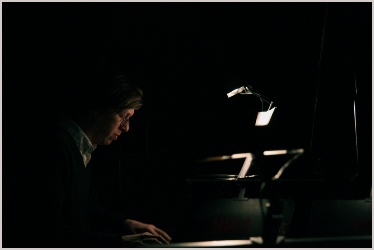
Magnus Granberg
Reviews
“Ist gefallen in den Schnee, lasting sixty-one minutes, consists entirely of a November 2010 recording of the title composition by Magnus Granberg. For the recording Granberg's group Skogen—in which he plays piano—is expanded to a nonet including two non-Swedish guest musicians, Angarad Davies on violin and Toshimaru Nakamura on his instrument of choice, the no-input mixing board. Strings, vibraphone, percussion, bowls and glasses plus electronics complete the group's line-up, giving it a soundscape that extends way beyond that of a chamber group.
Opening with delicate, carefully-spaced piano notes, the composition initially sounds most reminiscent of Morton Feldman. Remarkably, Granberg himself says its rhythmic material and other temporal proportions are derived from two different songs from Schubert's song cycle Die Winterreise (the album title is definitely a line from one of its songs, "Wasserflut"). Its tonal material, however, is derived from a jazz song that he has forgotten. If the composer had not dropped such clues, those sources would not be at all apparent from the music itself.
The piece subtly combines composition and improvisation. Granberg comments, "Perhaps one could say that I provide a potential which could be realized in innumerable ways, but the actual realizations are always the result of what decisions the musicians make throughout the piece; formal differentiation occurs spontaneously as a result of an improvisational process."
With any nine-member ensemble that includes improvisation, there will always be the risk that the players will get in each other's way or that the music degenerates into a series of individual contributions leading to cacophony overall. Granberg's composition deftly manages to sidestep these potential problems, avoiding any feeling of clutter or messiness, while achieving a beautiful sense of space, openness and tranquility. The composer's own piano playing is central to that—his economical contributions set an example to the other players and act as the backbone of the piece.
The ringing sounds of Henrik Olsson's bowls and glasses plus the electronic tones from Nakamura and Petter Wästberg contrast effectively with the ensemble's conventional instruments while being entirely consistent with the mood of the piece and the sound of the rest of the group. Across its duration, Ist gefallen in den Schnee creates its own rules and logic, resulting in a composition that demands to be heard again and again. Sublime.”
John Eyles, All About Jazz
“Rarely has a title been as precise as for this album, capturing a feeling in mid-phrase "has fallen in the snow", offering possibly one of the most delightful and lightest musical dishes you may have consumed ever.
The band consists of Angharad Davies and Anna Lindal on violin, Toshimaru Nakamura on no-input mixing board, Petter Wastberg on electronics, Leo Svensson Sander on cello, Erik Carlsson on percussion, John Eriksson on vibraphone & crotales, Henrik Olsson on glasses and bowls, and Magnus Granberg on piano, but equally rarely will you have heard a nonet with a more open, lightfooted and fragile sound.
Magnus Granber takes the lead on piano, using sparse notes as the reference for the other musicians who intervene with the beauty and transparance of single snow flakes, single-toned, well-paced and creating an atmosphere of perfect tranquility and peace.
The album contains one single track, lasting just over an hour, and despite its minimalism is not boring for one second. On a superficial level you might say that nothing much happens, but quite the contrary is true, nothing is ever the same, as the partly composed piece evolves with subtle and sometimes unexpected sounds. As with other bands using the same approach, such as "Dans Les Arbres", "Silencers" or "Mural", the musicians' utter instrumental control and restraint are astonishing, resulting in this wonderful coherence that is the result of high level common improvisation, made interesting because of the real intensity of the created soundscapes.
Again, as with lots of new music in the past decades, Scandinavian musicians offer us new aural experiences, and indeed very welcoming ones. Highly recommended!”
Stef, Free Jazz
“Ist gefallen in den Schnee is a single, hour long composition scored by Magnus Granberg and performed by the group Skogen, which on this occasion consisted of nine musicians, seven of them Swedish and two of them (Toshimau Nakaumra playing no-input mixer and Angharad Davies playing violin) guest musicians visiting the country. The Swedish line up were, Anna Lindal, (violin) Leo Svensson Sander, (cello) John Eriksson, (vibraphone and crotales) Erik Carlsson, (selected percussion) Henrik Olsson, (bowls and glasses) Petter Wastberg (objects, contact mics and mixing board) and Granberg himself playing piano. In an in-depth interview about the composition at the AT website, Granberg states that the score uses two points of source material; a couple of Schubert’s songs, which he has somehow used to drive the rhythmic sections of the composition, and a jazz melody, from which he has derived the tonal parts. Exactly how he has done this is far from clear, and before I had read the interview I was in firm agreement with the AT label owner Simon Reynell’s viewpoint that the music seems to be a kind of collision between the music of Morton Feldman and an intervening improvised sense of disruption.
The music is extremely lovely to listen to, a really nice balance between semi-classical instrumentation and the abstraction of raw electronics. Ist gefallen in den Schnee (the title apparently comes from a line in a Schubert song and might translate to Is fallen in the snow) opens with a slow, clockwork like structure of chiming percussion and plucked strings mixed with twittering electronics from (I think) Nakamura. Immediately I think of Feldman, and when the violin strings join the chains of simple, slowly picked out piano the resemblance is even more striking, but all along the chamber feel of the music is disrupted slightly by the electronics, which are apparently much more loosely scored for than the other parts, so allowing the improvisatory qualities of these musicians to interact with an otherwise slowly turning, lethargic but steady rhythmic pulse. It really does feel like a late Feldman work with electronic accompaniment, and that’s not a bad thing at all in my opinion.
As the piece slowly develops it becomes more dense, with less room for silence and individual sounds less easy to pick out and focus upon, but the sense of precise timing very apparent and the slow pace maintained immaculately throughout, even when the thickness of the varying sounds together could prosily have lead to an excited quickening of the pace. Several of the musicians’ inputs are familiar to me; Carlsson’s particular use of circular percussive chimes, the lightness of Angharad Davies’ violin stroke, the filigree scribbles of Toshi Nakamura behind a mixing board, but this CD isn’t about individual voices but rather a carefully structured work for a nine piece group that maintain a sense of control throughout, even with some of their input entirely improvised. There are some gloriously beautiful moments. At nine minutes in when the piano mixes its way through some glowing cyclical percussion is one such moment to savour, but they actually come thick, if not fast. While first listening to this music a couple of weeks back I found myself asking myself why the two electronics musicians were here on this CD, when their role seems only ever to be about disrupting what might otherwise be a very typically New York School piece of composition. I didn’t think this way for too long though, as I soon realised that the real intrigue in this music comes from the way two musical worlds seem to collide, the almost regimentally arranged acoustic instruments and the free flowing electronics. While the feedback and fizzing remain very slightly in the background throughout and never try and push to the acoustic sounds out of the way their presence here is a telling one, reminding us that we aren’t listening to something tightly dictated but an experiment in such a collision of approaches and outcomes. The end result of all of this is a quite enchanting, often intrinsically fascinating hour of music that questions itself as much as it challenges the individual taste of its listenership. Lovely stuff, quite beautiful but open to examining exactly that notion about itself.“
Richard Pinnell, The Watchful Ear
“Ist gefallen in den Schnee est une longue pièce d'une heure écrite par le compositeur suédois Magnus Granberg et interprétée par l'ensemble Skogen, soit: Granberg lui-même au piano, accompagné de différents collaborateurs suédois, Anna Lindal au violon, Leo Svensson Sander au violoncelle, John Eriksson au vibraphone et crotales, Erik Carlsson aux percussions, Henrik Olsson aux bols et verres, Petter Wästberg aux objets, table de mixage et micro-contacts, ainsi que deux musiciens célèbres et étrangers, Angharad Davies au violon, et Toshimaru Nakamura à la table de mixage bouclée sur elle-même.
Dans l'interview de Granberg publié sur le site d'AT, on peut y lire que les sources rythmiques et tonales de cette pièce sont deux œuvres de Schubert d'un côté, et un standard de jazz de l'autre. Mais il faut le reconnaître, il est absolument impossible de reconnaître l'un des deux durant toute cette heure. Comme Simon Reynell et Granberg le reconnaissent, il est beaucoup plus facile d'entendre avant tout l'influence de Cage et de Feldman. La réappropriation des matériaux musicaux est entière, très subtile et intime, Granberg a su tirer parti d'un matériau ancien pour créer une musique extrêmement personnelle et nouvelle, sans aucun rapport identifiable à ses sources.
Qu'est-ce qui m'a frappé en premier lieu? Tout d'abord, c'est le caractère très aéré de cette pièce, relativement au nombre d'instrumentistes. Ist gefallen in den Schnee ressemble bien plus à la transposition d'une pièce pour piano qu'à une œuvre orchestrale, les instruments ne se superposent pas réellement, sauf durant quelques résonances, le silence intervient constamment entre chaque intervention pointilliste. Chaque instrument pointe une note, dessine une couleur qu'il répète, les notes pointées prédominent constamment et on ne trouve que rarement des accords ou des superpositions de couches sonores, sauf en guise de ponctuation au début ou à la fin d'une partie (parties qui sont délimitées de manière floue, mais qui empêchent tout de même de qualifier cette pièce comme étant linéaire, même si elle l'est d'une certaine manière), ou pour jouer sur l'intensité et la puissance.
Ensuite, c'est la durée, elle-même liée aux répétitions. Les répétitions inaltérables de notes précises (jouées avec précision sur la même hauteur, avec la même intensité, et durant une durée constante selon les mêmes attaques par chaque musicien), de motifs harmoniques ou rythmiques, et de couleurs, toutes ces répétitions étirent la durée de cette pièce déjà quelque peu linéaire. Comme chez Feldman, la répétition intervient pour modifier la perception du temps, pour faire agir souvenirs, mémoire, ennui, et intellection. La durée déjà considérable de Ist gefallen in den Schnee se trouve dilatée par le caractère répétitif de l’œuvre, mais c'est ce même caractère qui permet d'envoûter et d'absorber l'auditeur pour un long et magnifique voyage hivernal et nordique, froid et coloré.
Je me réfère encore à l'interview de Granberg que je l'ai lu en diagonale, mais il semblerait que tout ne soit pas écrit: si le compositeur a noté des indications de hauteurs, de rythmes, de couleurs, une marge d'improvisation est tout de même laissé aux instrumentistes. Mais à vrai dire, je ne veux pas savoir dans quelle mesure Ist gefallen in den Schnee est écrit ou composé, le processus de création semblant quelque peu ridicule devant la beauté de cette longue fresque. Car cette pièce est un mélange étonnant de simplicité tonale et de complexité rythmique, d'une beauté saisissante; et qu'importe si cette beauté hors du commun et cet étrange mélange soient l’œuvre de l'intelligence compositionnelle ou du talent de chaque musicien. Ils viennent forcément de ces deux paramètres, et l'important est la force avec laquelle cette oeuvre peut faire voyager l'auditeur à travers un voyage inouï, inédit, chargé d'une multitude de couleurs, de tonalités, d'intensités, à travers une linéarité mouvante. Bienvenue sur les collines enneigés de Suède, avec sa lumière et ses couleurs incroyables, son froid surprenant sans être repoussant; laissez-vous emmener à travers ce voyage intimiste, sensible et nouveau. Car l'écoute entre les musiciens est extrêmement proche et attentive, la moindre intervention est prise avec un sérieux et écoutée avec une attention percutante, ce qui n'est pas sans renforcée la force de chaque son et la poésie qui se dégage immédiatement de chaque intervention, ainsi que de l'ensemble de cette pièce.
On pourrait certainement dire encore beaucoup de choses sur Ist gefallen in den Schnee, car chaque écoute découvre de nouveaux paramètres et de nouvelles composantes de cette pièce très riche. Je finirai seulement et simplement par dire qu'elle est juste magnifique, et par remercier Simon Reynell, Magnus Granberg, et l'ensemble des musiciens, pour cette expérience musicale inespérée.”
Julien Heraud, Improv-Sphere
“If it is difficult - and probably unnecessary - to determine what is "semi-composed" and what is "semi-improvised" in the exciting hour that this delicate piece lasts, we must nonetheless recognize that Magnus Granberg (piano/composer) has succeeded in creating an enchanting environment and a vehicle for contemplation, with the help of the group Skogen in Stockholm in autumn 2010.
Even without its title and cover (both of which are charming for this Swedish Winterreise), the music stands up on its own: elegant, dream-like in its suspension, and it's Feldman who soon appears amidst the desks and music stands of Angharad Davies (violin), Anna Lindal (violin), Leo Svensson Sander (cello) and John Eriksson (vibraphone). Then the fine electric tension is supplied by Erik Carlsson (percussion), Henrik Olsson (bowls & glasses), Petter Wästberg (objects, microphones, mixer) and Toshimaru Nakamura (no-input mixer, which is a real cage of piercing, humming insects), these four giving the Feldmanesque halos, drops and slow comets a further quality of mystery. Although the group has expanded its workforce (from its work for the label Bombax bombax), Skogen here achieve a wonderful balance: parsimonious, subtle, but always consistent. Bravo!”
Guillaume Tarche, Le Son du grisli
“On the Another Timbre website, composer/pianist Magnus Granberg is grilled about how Ist Gefallen in den Schnee came out sounding more Feldmanesque than his actual source material: a jazz standard (Granberg can’t remember which) and two songs from Schubert’s Winterreise. He explains that Schubert’s songs provided him with a rhythmic and temporal framework, while the jazz standard lent him the tonal material, the point being “to reconcile musics with different social connotations”. Presumably Granberg’s mixed ensemble of improvisors (including violinist Angharad Davies and Toshimaru Nakamura on no-input mixing board) and ‘straight’ players is making much the same point, although everything is buried at such a subterranean structural level that the distinction evaporates in the listening. Granberg has thought through the ‘whys’ carefully: players are handed ‘pools’ of material, with suggestions of how to treat it, and his hour long structure balances formal rigidity with an internal energy clearly deriving from musicians listening, working out where to go next.”
Philip Clark, The Wire
“Antoine Beuger recently lamented the fact that so many interpretations of John Cage's music lack a basic sense of beauty and phrasing, an observation that came to mind as I listened to these four new releases from Another Timbre. Whether for large ensemble, trio, duo or solo player, and whatever the syntax employed in the music's construction, each is imbued with a sense of beauty that is often overwhelming. Sometimes raw, often sparse and occasionally embracing something akin to silence, these are some of the strongest offerings in the fairly young label's catalogue. Skogen's Ist Gefallen in den Schnee and Taus's Pinna share a fairly strict focus in terms of pitch content, while Thread (Annette Krebs, Magda Mayas and Anthea Caddy) and Atto (Osvaldo Coluccino) tend toward a more disjointed aesthetic, yet all derive, at least in part, from the music Cage left, whether from the wild pointillism of his 1970s etudes, the never-silence of 4:33 or the majestic long-toned grandeur of late orchestral works such as 103.
This is not to say that Cage is the sole point of reference: certainly these musicians are well versed in other grammars. I remember hearing Luciano Berio's completion of Schubert's 10th symphony and being struck by the "dream" music that connects the fragments of Schubert's unfinished manuscript. It isn't just that pianist and composer Magnus Granberg's vision takes its title from a Schubert song: the more time I spend with it, the more I hear the music on Skogen's new disc to be a natural follow-up to Berio, taking his ideas to the next level. In an interview with Granberg on the AT site, Simon Reynell likens the music to Feldman, but I also hear some of Berio's busyness and layering in the ever-evolving textures (the Stockholm-based ensemble has been expanded from five to nine players, including Toshimaru Nakamura and Angharad Davies). While a slow and somewhat clichéd movement from sparse to full textures pervades the disc, the way in which the space is filled is anything but expected. In the single movement, the ensemble glides through a series of pitch areas, some intervallic, others not, but each leading naturally to the next. Though the dynamic level is in constant flux, there's a sense of unity as each sound takes its place, as if fitting into a puzzle. But just when the formula seems clear, there's a stunning moment of near silence and vast space, punctuated only by Nakamura's electronics, before the activity begins again and several unexpectedly louder sounds infiltrate the space. This flouting of (what has become) established form is one of the ingredients that makes the disc so successful: this music, whose wide dynamic range and brief glimpses of tonality within a rigid formality, is refreshingly beyond simple categorization, though a tonal palette similar to Cage's prepared piano music of the late 1930s and 1940s provides an easy point of reference.”
Marc Medwin, Paris Transatlantic
“Ist gefallen in den Schnee
(2012, Another Timbre at47)
Wer ist oder sind Skogen (schwedisch für »Der Wald«)? Und ist Skogen in den Schnee gefallen? Und was in aller Welt hat diese Minimal-Jazz-Musik mit dem Gemälde von K.E. Bjurberg zu tun? Fragen über Fragen. Doch entscheidend ist: Alle weltlichen Fragen verblassen angesichts der aparten, fragilen Schönheit dieser 61 Minuten langen Traumreise. So viel sei verraten: Komponist und Pianist Magnus Granberg gelang es in grandioser Weise, ein Ensemble aus neun internationalen und vor allem äußerst unterschiedlichen Musiker/innen zu bilden, das in radikaler künstlerischer Freiheit ein superb dicht und homogen gewobenes Werk einspielte, halb komponiert, halb improvisiert.
Zu Beginn tut man sich ein wenig schwer mit dem Geräuscharsenal und der scheinbaren Ziellosigkeit dieses einen, ununterbrochenen Stücks. Es sei jedoch dringend angeraten, den passenden Zeitpunkt und Ort für den Genuss von Skogen zu finden. Nah an Cage und Feldman, auch an Mark Hollis (bzw. späten Talk Talk), aber ebenso dicht am impressionistisch-ungreifbaren Kosmos des norwegischen Sofa-Labels, mit dessen sehr ähnlich gelagertem Quintett Koboku Senjû sich nicht nur die prägende Mitwirkung des »No-Input Mixing Board«-Spielers Toshimaru Nakamura überschneidet, sondern auch die Natur- und Schnee-Assoziationen, so erweist sich Skogen als dem norwegischen Ensemble absolut ebenbürtige Gruppe.
Und sie musiziert, neben den beiden genannten Instrumenten, mit zwei Violinen, Cello, Vibrafon, Crotales (alten Zimbeln), Percussion, Schalen, Gläsern, Objekten sowie Kontaktmikrofonen und Mixing Board. Was für eine Mischung! Was für ein Klangbild! Ach ja, und am Ende ergibt auch der Titel einen Sinn, den er ist ein Zitat aus Schuberts »Winterreise«”
IJBiermann, Nordische Musik
“Pocos lugares existen a los que me parezca tan grato regresar como aquellos en los que nunca he estado (Charles Dickens)
El oxímoron es la combinación en una misma estructura sintáctica de dos palabras o expresiones de significado opuesto que originan un nuevo sentido. En el campo de la retórica se denomina oxímoron a todo recurso del lenguaje o figura literaria consistente en la unión de dos términos contradictorios que, lejos de excluirse, se complementan para crear un tercer concepto o para resaltar el mensaje que transmiten. La palabra oxímoron tal vez no forme parte del vocabulario de la mayoría de las personas; no obstante, cabe afirmar que dicha figura retórica aparece con frecuencia en nuestra vida cotidiana cuando –por citar unos pocos casos- se habla de “realidad virtual”, “déficit cero”, “ciencia ficción”, “café descafeinado”, “sana envidia”, “única opción”, “encontrarse perdido”, ‘frío infernal” o “tensa calma”.
La idea de complementar una palabra con otra que tenga un significado opuesto también puede ocultar, bajo su apariencia absurda y sentido metafórico, un agudo sarcasmo. A modo de ejemplo ahora viene a mi mente aquella memorable frase de Groucho Marx que –oxímoron mediante- decía: “la inteligencia militar es una contradicción de términos”.
En la literatura abundan lustrosos ejemplos en el uso del oxímoron: William Shakespeare en la tragedia Romeo y Julieta habló de un “santo maldito, honorable villano, engaño leal’; Lope de Vega -en su soneto Sosiega un poco, airado temeroso- pedía “déjame en paz, pacífico furioso, villano hidalgo, tímido arrogante, cuerdo loco, filósofo ignorante”. Mientras que Charles Baudelaire, en su poema Las Dos Buenas Hermanas, detallaba “placeres espantosos y dulzuras horrendas”, Rodrigo Cota de Maguaque -en Blindes Schauen, dunkle Leuchte- imaginó una “vista ciega, luz oscura, gloria triste, vida muerta” y Jorge Luis Borges describía el andar de un personaje de El Aleph como “una graciosa torpeza”. De todos modos, si existe un arquetipo de oxímoron es –justamente- la palabra oxímoron, ya que su raíz etimológica proviene de un helenismo que une los lexemas oxýs (agudo, punzante) con morós (fofo, tonto).
A estas alturas usted debe intuir claramente adónde voy con todo esto; pero si no lo sabe aun, no seré yo quien se lo explique porque para eso están los que sí lo saben (¡?). Además tengo dos razones indiscutibles para semejante afirmación: la primera yla segunda. Ycréame que está bien que así sea, porque si hubiera una tercera, una cuarta o una quinta, las razones indiscutibles ya no serian dos sino… tres, cuatro o cinco.
Entretanto, aprovecho para decirle que lo contrario al oxímoron es el pleonasmo. Término que describe a la figura retórica que consiste en la adición de palabras que no son necesarias en una frase, debido a que su significado está implícitamente incluido en ella. El pleonasmo se manifiesta sutilmente en frases como “constelación de estrellas” (una constelación es siempre un conjunto de estrellas), “polos opuestos” (los polos son opuestos por definición) o “funcionario público” (un funcionario es aquél que desempeña un cargo público) y también en redundancias explícitas (aunque algunas parezcan auténticas “rebuznancias”) tales como “callate la boca”, “entrar adentro”, “beber líquidos”, “comete la comida” y ni qué hablar de aquellos que están orgullosos de ser “padre de tres hermosos hijos” -como si les fuera posible ser padre de un nieto, un cuñado o una tía- o de quienes aseguran haber visto algo “con sus propios ojos” (si usted puede ver las cosas con los ojos de su hermana, avíseme) o hablan de sus “proyectos a futuro” (acá no estoy tan seguro, de hecho tengo en mente varios proyectos para modificar mi pasado). La verdad es que muchos de estos pleonasmos me dibujan una sonrisa en los labios; lo cual también es un pleonasmo ya que no conozco a nadie que sonría con la nariz, los tobillos, el hueco poplíteo o el músculo esternocleidomastoideo.
Ahora que tenemos en claro que el oxímoron no es un medicamento ni el pleonasmo una enfermedad (aunque ante un cuadro de pleonasmo no dudaría en recetar un oxímoron cada seis horas), podemos regresar a la frase de Charles Dickens que encabeza este comentario. Su ubicación de privilegio en el texto no sólo obedece a que su enunciado incluye un oxímoron ni se debe únicamente a que la escucha repetida del álbum Ist gefallen in den Schnee provoca una sensación auditiva similar al pensamiento enunciado por Dickens, sino también a que la propuesta de Skogen sólo puede describirse de manera apropiada mediante el uso indiscriminado del oxímoron. Hablar de la estética de esta banda originaria de Estocolmo y liderada por el pianista sueco Magnus Granberg, implica recaer en contradicciones u opuestos aparentes tales como “improvisación escrita”, “composición improvisada” o –según su autor- “obra semi-compuesta” y nos puede llevar a ensayar alguna descripción bufa como “jazz camerístico electro-acústico”, “música clásica improvisada”, “free-ambient” o “avant-soundscapes” e incluso no faltará quien, al borde del paroxismo y la enajenación definitiva, se arriesgue a definirlo utilizando una palabra ya caída en desuso: “música”.
La idea conceptual pergeñada por Magnus Granberg en Ist gefallen in den Schnee se inspira en elementos tonales derivados de un tema de jazz (que su autor dice haber olvidado) y en material rítmico y proporciones temporales provenientes de dos piezas de Franz Schubert extractadas de su ciclo de liederes de 1828 Winterreise, Opus 89 (“Viaje de Invierno”) sobre textos del poeta Wilhelm Muller contenidos en Poemas de los papeles legados por un cometa del bosque errante. Canciones de la vida y el amor, de 1823. De hecho, el título del álbum de Skogen es un fragmento proveniente del primer verso de una de esas canciones -Wasserflut (Torrente)- cuyo texto original en alemán dice: “Manche Trän’ aus meinen Augen; Ist gefallen in den Schnee; Seine kalten Flocken saugen, Durstig ein das heiße Weh” (“Muchas lágrimas de mis ojos han caído en la nieve; sus fríos copos beben sedientos el cálido aliento”).
La obra de Skogen armoniza los contrastes implícitos en esas fuentes de inspiración a través de un lenguaje musical cercano a la icónica visión composicional de John Cage y, muy especialmente, de Morton Feldman. En su diseño estético se asocian algunos conceptos innatos a la idea comprendida en las “piezas gráficas indeterminadas” de Feldman (en donde el compositor sólo sugiere cómo tratar el material dejando la decisión final a elección del intérprete), el empleo de una inusual agrupación de instrumentos, la ausencia de clímax y crisis (factor que puede sorprender a oídos acostumbrados al drama musical), duración excesiva (la única pieza incluida en el álbum supera los sesenta minutos y se desarrolla sin interrupciones ni detenciones), la utilización de módulos repetitivos de evolución lenta que reemplazan la idea de variación tradicional por un proceso gradual de mutación, un pertinaz sentido de espacialidad asociado al expresionismo abstracto, el tratamiento del sonido como algo que tiene sentido más allá de la melodía o la armonía y, en definitiva, una innegable aspiración por conciliar músicas con diferentes connotaciones sociales mediante una disposición integradora que permita al compositor habitar en un mismo plano que el oyente.
En Skogen, la búsqueda deliberada de integrar los opuestos se acentúa mediante una disposición tímbrica que confronta instrumentos tradicionales representados por el piano de Magnus Granberg, los violines de Angharad Davies y Anna Lindal y el cello de Leo Svenssson Sander con los electrónicos de Petter Wästberg o la música no idiomática que provee la no–input mixing board (mesa mezcladora que se retroalimenta en forma continua sin fuentes externas) de Toshimaru Nakamura y enfrenta a los instrumentos de percusión “convencional” a cargo de Erik Carlsson y John Eriksson con los objetos (vasos y cuencos) utilizados por Henrik Olsson.
Magnus Granberg, en Ist gefallen in den Schnee –de igual modo que lo que ocurre con un oxímoron-, hace que esos opuestos se integren para crear un nuevo concepto en donde sus componentes, en lugar de excluirse, se complementen. Por ello, en el álbum de Skogen las referencias a la música de Schubert asoman, es cierto, pero sin ceder plenamente a ellas ni aceptando la concepción decimonónica del romanticismo clásico; en tanto que las influencias provenientes del jazz se manifiestan en la prerrogativa adjudicada a la improvisación pero desechando las metodologías convencionales del género para entronizar en su lugar la “emisión de sonido” por sobre la interpretación.
El fascinante mundo sonoro diseñado por Skogen –sorprendentemente vanguardista y placentero, paradojalmente contemporáneo y fuera de su tiempo- es gobernado por el micro-cromatismo y texturas similares pero en perpetuo movimiento que van creando una falsa sensación de inmutabilidad que hace imposible definir partes o relacionar algo con el comienzo o el final. Todo esto nos va conduciendo sutilmente a no esperar nada en particular de la obra, salvo dejarnos llevar hasta alcanzar una sensación de abandono.
Hasta alcanzar un estado en donde ya no importan las fuentes de inspiración ni las influencias. Hasta alcanzar ese instante supremo en donde sólo existe la música.
Después de escribir una pieza ya no importa el tema en que se inspiró, sólo queda la música (Morton Feldman)”
Sergio Piccirilli, El Intruso
“Titeln är hämtad från Schuberts sångcykel Winterreise. Det kan ge näring till spekulationer varför det är på det viset. Har de tänkt på den omfattande panoreringen av ett känslotillstånd? Eller kanske det finns en undertext, där naturligtvis Heinrich Heines Tyskland, en vintersaga strömmar med sin vassa samtidskritik, senare som bekant uppföljd av Göran Palm?
Eller är det bara ett passande namn för den kalla, stillastående stämning, som råder i musiken. Likt pulsande i djup snö är rörelserna små och begränsade och sinnena uppmärksamma på den minsta förändring. Det behöver inte råda motsättningar mellan de olika associationskedjorna. Det är ett slags musik, som inbjuder till att lyssna efter en hållning, en anledning och ett slags åtminstone fragmentarisk berättelse.
Instrumenteringen är kammarensemblen. Magnus Granberg har komponerat och leder det hela med ett fåtonigt piano. Som en ilande tand hörs Toshimaru Nakamuras no-input mixing board. Peter Wästberg gör visslande och knastriga ljud på vanligt mixing board och olika förstärkta grejer. Liksom Henrik Olsson. Den som vill finna delikatesser hör på Erik Carlssons slagverk och den magnetism han utverkar i klang, intonering och frasering med de andra.
Så har vi en lyhörd stråksektion med två violiner och cello, Anna Lindal, Angahard Davis och Leo Svensson Sandler. Små ljud, filigransarbete och koncentration. John Erikssons vibrafon är så utklädd att den knappt går att känna igen. Det är hela ensemblen. Den agerar som en kropp, där lemmarna förvånat reagerar på varandra. Som att se sig naken och rörlig i spegeln.
För det är många reflektioner i denna musik. Men inga ögonblickliga bilder, snarare en allt långsammare fördröjning. Det låga tempot uppvägs av en koncentration, där gnissel, ljud, små slag, enstaka toner, ljudkluster tätnar. Det känns som ett ljus. Om jag tänker på Schubert är det kvällen eller dagen som bryter igenom. Tänker jag på Heine (eller Palm) är dessa bländande stegringar ett slags sårighet, en kärvhet, där landskapet blir alltmer påträngande plågsamt. Tröttheten i stegen är inte personlig men hänger ihop med en omgivning som framkallar en inre upprördhet. Som att i spegeln upptäcka att bakom ryggen håller dystopin redan på att inträffa.
Musikaliskt har albumet ingenting med Schubert att göra, om vi bortser från ett avvaktande stämningsläge, där musiken tar oss i handen ut i ett okänt landskap, på en vandring utan kännbart mål. Det är Morton Feldman som ritat den musikaliska kartan. Således måste vi lyssna på mellanrum, varje ton, hur de enskilda instrumenten skapar oväntade ljud. Och hur dessa klanger möter varandra, går in och ut som sättstycken på en teater. Variationen är inte stor, men oändlig vid närlyssning. En klocka, eller är det vibrafonen?, träffar trumstockarna, en cymbal skäller till; en liten skärmyttring som snabbt lugnas av violinernas förströdda pizzicato och det omutliga pianots enskilda toner. Ett glas, någon snurrar fingret på ett glas, en visslande ton från friktionen mot en cymbal…
Ja, musiken är fylld av konstateranden, som om det mest fanns substantiv, och när man slår dem mot varandra uppstår möjligen ett och annat adjektiv. När öronen doppats länge i denna brygd börjar små fragment att röra sig som om de sökte efter varandra för att bli enkla melodier. Ett slags förstrött trallande.
Magnus Granberg och Skogen har skapat en musikalisk spegel, där både vi själva, omvärlden och vissa skarpa spår i historien reflekteras. Schubert står nog som en garant för det romantiska i tilltaget.”
Thomas Millroth, Sound of Music
“Om än titel och delar av materialet kommer från 1800-talets Schubert, relaterar Skogens sparsmakade musik till 1900- talets Morton Feldman. Men niomannabandet, under ledning av kompositören och pianisten Magnus Granberg, befinner sig ändå i ett tydligt 2000-tal.
Stycket klockar in på en timme och det tar tid på sig. Runt Granbergs fåordiga piano kretsar välspelade violiner, cello, slagverk, vibrafon och elektronik, som utströdda klanger eller i gemensamma färder. Tveklöst är det ensemblen som har huvudrollen, det är här musiken finner sin stora dynamik och koncentration, även om tyngdpunkten förflyttas mellan instrumenten. I den bemärkelsen är denna märkvärdiga musik faktiskt organisk. Dessutom i grunden vacker, trots sträva och kraftfulla partier.”
Magnus Nygren, Svenska Dagbladet
“Det är enastående spänningar som mannen bakom projektet Skogen, musikern och ljudkonstnären Magnus Granberg, får fram i sin drygt timslånga komposition för nio instrumentalister. En av utgångspunkterna är Schuberts sångcykel Winterreisse, det är därifrån titeln är hämtad. Men den ytterst återhållsamma och minimalistiska musiken påminner också om Morton Feldmans sena musik: få toner, glesa strukturer, ett kontemplativt spel som gör tystnaden alltmer laddad. Efterhand framträder en sinnlig skönhet och en sorts överraskningens melodikänsla: ansatserna till melodier blir hela symfonier, vidsträckta tonlandskap tecknade med några få pennstreck.”
Magnus Hagland, Goteborgsposten
“Despairs Had Governed Me Too Long is the third release on Another Timbre by the group Skogen, an electro-acoustic ensemble formed by Swedish musician and composer Magnus Granberg. Over the course of these releases, Granberg and ensemble have documented a collective approach to utilizing compositional structures for open-form ensemble playing. Their first release was an extended reading of “Ist gefallen in den Schnee,” a piece by the leader derived from Schubert’s song cycle “Die Winterreise” as well as an unidentified jazz song. The composition utilized these sources to provide pools of pitch, rhythmic, timbral, and melodic material along with a temporal framework for employing the material over the course of the reading. For their second release, Rows, Granberg invited composer Anders Dahl to provide a series of short compositions based on twelve-tone theory, with room for interpolation of attack or the replacement of notes with un-pitched sound or noise.
For their latest release, Granberg again provided an extended form, this time drawing on English Renaissance composer John Dowland’s song “If my complaints could passions move”. A careful listen reveals how the foundational elements of Dowland’s piece provides a subtext of mood and flow for the musicians to inhabit. (Skogen is the Swedish word for forest and Granberg has talked about the idea that his music would be “like an environment, perhaps a forest in which inhabitants with different characteristics could move freely in accordance with the environment and their own and each other’s properties and abilities.”) Integral to the success of the music is the choice of musicians and instrumentation of the ensemble freely mixing traditional Western instrumentation with the leader on piano and clarinet, Angharad Davies and Anna Lindal (violin), Leo Svensson Sander (cello), John Eriksson (marimba, vibraphone), Erik Carlsson (percussion); non-traditional pitched instruments with Ko Ishikawa (sho) and Henrik Olsson (bowls and glasses); and electronics with Toshimaru Nakamura (no-input mixing board) and Petter Wästberg (contact microphones, objects).
Equally important is the shared sensibility of the participants, all of whom are committed to a stately collective restraint. In an interview on the Another Timbre site, Granberg explains it like this: “The density of musical events is comparatively low. I myself am very fond of the idea and practice in, for example, Javanese gamelan music, where some of the musicians, depending on their instrument, may just play one, two or perhaps four strokes during musical cycles which sometimes may last for several minutes. Japanese Gagaku music is another East Asian orchestral tradition which partly works in a similar way, I think. Other reasons may perhaps be found in the instrumentation (which is predominantly made up of decaying sounds) or the way the acoustic material is distributed throughout the tonal spectrum.”
The piece starts out with spare prepared piano notes and ultra-subtle gradations of plucked strings and reedy sho, slowly introducing ringing percussion and shadowy glitched grit of electronics. What is so striking here is the way the ensemble is willing to sit on things, never rushing. The piece proceeds on the accrual and dissipation of detail rather than structural notions of arc of densities or dynamics. Notes are sounded and percussion instruments are struck with attention to attack and decay not only of the sounds themselves, but the way they interact with the ensemble.
Yet there is nothing constrained about the music. Listen to how, 10-minutes in, a section of dynamic activity breaks out, spurred on by sputtering electronics. The same thing occurs about 40 minutes in as a swell of low rumbling electronics rises out of the mix, welling in to collective density in the last section, with string ostinatos playing off of contrapuntal piano and percussion as sho and electronics weave clouds of coloration. But rather than get pulled off into a collective fray, the ensemble absorbs the activity into the overarching flow of the piece, utilizing it to segue in to new balances of texture and timbre while maintaining the methodical pace. Melodic fragments are used in much the same way, as some voices coalesce around an emerging thread while others move in asynchronous paths. This strategy is used throughout to nudge the focus and planes of interaction, maximizing the range of the instrumentation of the ensemble in ever-shifting notions of sonic fields. Another Timbre label-head Simon Reynell has shown a continued commitment to Granberg and Skogen and one looks forward to hearing how this project will develop.”
Michael Rosenstein, Point of Departure
“On their third release for Another Timbre, Skogen – The Forest or Woods in Swedish – present an extended composition by founder Magnus Granberg. Like their first release Ist Gefallen in den Schnee, which drew on material from Schubert’s Winterreise, it has a classical basis – a song by 17th century English composer John Dowland. Audibly, the connections are distant, except in the mood of darkness and melancholy, not to say despair and depression, they share with their models. That distance partly results from the openness of the compositional process – players are apparently handed ‘pools’ of material, with suggestions of how to treat it.
The one continuous track of 57 minutes shows a restraint within timbral richness that’s reminiscent of another remarkable ensemble, Dans Les Arbres – though their forces and improvisational method are very different. Skogen’s soundworld is spare and minimal, yet its measured progress creates a feeling of slowly evolving rhythm – a numinous intensity heightened by often violent outbursts of percussion and white noise. Instead of the familiar arch-shape, the form ebbs and flows, with a rising intensity and activity in the later part of the piece.
There’s a distinctive mix of Western, East Asian and electronic resources. A kind of baseline electronic field is set up by Toshimaru Nakamura on no-input mixing board and Petter Wästberg on contact microphones and objects. This seems to draw in the acoustic sounds of ubiquitous Ko Ishikawa on sho, and Henrik Olsson on bows and glasses, and in a way familiar from modern composers such as Nono and Xenakis, makes them sound somehow electronic too.
Granberg’s stated aim is to create a music and performance practice which draws no clear distinction between composition and improvisation. In this, as he says, he’s following developments since the 1990’s. But in contrast with the spontaneity and excitement of improvisation, there’s a sense of inevitability and organic unity that belongs to the most compelling composition. It creates a singular atmosphere of drama and mystery, with an ethos that’s totally involving.”
Andy Hamilton, The Wire
“With their previous two Another Timbre releases, Ist Gefallen In Den Schnee (2012) and Rows (2013), Magnus Granberg's large international ensemble Skogen established themselves as purveyors of exquisitely-played spacious music, that transcends the composition-improvisation border and makes beguilingly beautiful listening. On the 2012 album, a nine-member version of the group played a one-hour-plus rendition of Granberg's title piece. On Rows, an eight-member version—substituting Ko Ishikawa on sho for Leo Svensson Sander on cello and John Eriksson on vibraphone—played nine shorter pieces composed by Anders Dahl.
For Despairs Had Governed Me Too Long, which was studio-recorded in Stockholm in November 2012, at the same session as Rows, the group swells to a ten-piece—retaining Ishikawa while seeing the return of Sander and Eriksson. Once again they play an extended Granberg composition, the fifty-six minute title piece. As with "Ist Gefallen In Den Schnee," Granberg cites the influence of a classical piece on his composition—this time, a song by 17th century English composer John Dowland. While that is certainly the source of the title "Despairs Had Governed Me Too Long," beyond that listeners need not dwell on the connection; the music here is more likely to cause them to seek out other Skogen recordings than some Dowland songs...
As before, Skogen displays the characteristics that have brought it acclaim: despite the size of the ensemble, its members do not get in each other's way and its music never sounds over-busy or cluttered; the instrumentation achieves a good balance between conventional chamber instruments and others, acoustic and electronic, affording them equal value and allowing them to complement each other; every sound made by every player is clearly audible, thanks also to the clarity of the recording.
If its title suggests that this composition could be melancholy or depressing, nothing could be further from the truth. In fact, it has an over-riding sense of peace and tranquility that is relaxing and uplifting in equal measure. Despairs Had Governed Me Too Long completes an impressive hat-trick for Skogen on Another Timbre.”
John Eyles, All About Jazz
”The great composer John Cage was an amateur mycologist, which is the formal term for someone who studies mushrooms. Cage was reluctant to draw a connection between his two passions, famously stating ''I am not interested in the relationships between sounds and mushrooms any more than I am in those between sounds and other sounds." Nonetheless, Cage's mushroom quest involved spending time in forests, where he undoubtedly lent his tremendous ears to the subtle doings of the natural world. In the same spirit, the group Skogen (which means ''the forest'' in Swedish) takes inspiration from the music that emerges from nature. And surely Cage has inspired Skogen's majestic long-form pieces, which explore the intersection between composition and improvisation, and warmly blend all manner of sounds and other sounds.
In Despairs Had Governed Me Too Long, the Sweden-based ensemble has created a gorgeous, 56-minute atmospheric field. The piece was composed by Skogen's founder, Magnus Granberg, who derived the harmonic and rhythmic foundations from 17th-century English composer John Dowland's song ''If My Complaints Could Passions Move.'' From this compositional jumping-off point, the group unfolds a gracefully meandering improvisation. It's a quiet space, but it is not silent: the piece is full of sounds that arise and disappear within the unobtrusive, hypnotic environment. Expansive single notes and pure chimes predominate, with discreet background evolutions that include tiny pools of dissonance, prisms of electronic shards, and sensitive drones. These shifting sounds are exquisitely paced, creating a harmonious progression that's both generous and patient.
And just as a forest welcomes all noises within it, this music mingles beautifully with the sounds of everyday life. If one plays the CD on a sunny spring day, the song gratefully accepts lawnmowers, children's laughter, and barking dogs. Likewise, during stormy weather, the music has space for raindrop patter, thunder rumbles, and the coo of a mourning dove. That's how wide-open this work is: the piece stands alone, and it is most definitely ''finished,'' but it is also receptive to changes and additions from the environment it is played in, which is a truly remarkable achievement.
As for the title, the piece does feel like the prolonged sensation of waking up after a long and perhaps despairing sleep. The music offers a host of subtle sensations, a slow thoughtful journey that shines a light and speaks of hope. This is a graceful, peaceful, meditative mindscape: it is life-affirming and, in the quietest way possible, wildly exciting. Perhaps this is what it sounds like to hunt for mushrooms in a hushed and ancient forest, with ears that are wide-open and free.”
Florence Wetzel, Squid’s Ear
“Med Despairs had governed me too long kommer Magnus Granbergs Skogen med sin tredje skiva på det välrenommerade brittiska bolaget Another Timbre. Liksom ensemblens inspelning av Anders Dahls Rows (också släppt på Another Timbre) är Despairs inspelad i Stockholm i november 2012. Despairs framfördes även live på Sound of Stockholm i samma månad och i min recension i Svenska Dagbladet skrev jag ”det är ett mycket vackert stycke musik i det långa formatet, framfört med fingertoppskänsla av ensemblen.”
När jag nu hör stycket igen – i en studioinspelning av Janne Hansson i Atlantis studio – har jag ingen anledning att ändra mig. Med utgångspunkt i harmoniken och rytmiken i ett stycke av John Dowland (1563-1626) skapar tiomannabandet ett subtilt mästerverk. Melankolin kan ibland förlama, här är den istället en förutsättning för kreativiteten. Att det faktiskt är tio personer i ensemblen är svårt att greppa. Ingen sticker ut, samtidigt visar alla prov på stor känslighet.
Vad det är man egentligen hör förvirrar många gånger. Är det överhuvudtaget komponerad eller improviserad musik? En försiktighet tycks genomsyra framförandet av stycket, samtidigt är varje klang så ytterst självklar och medveten. Man tycker sig höra melodiska mönster, men man kan inte vara helt säker. Kanske är bara materialet bekant, utan att man faktiskt hört det tidigare. Kanske är det just denna osäkerhet som bär fram stycket i hela dess 57 minuter. För trots att det befinner sig inom ett relativt begränsat stämningsområde tappar det aldrig i koncentration. Ensemblen lyckas tvärtom vända koncentrationen inåt mot varje klang så att varje moment blir berättigat.
I en intervju med Magnus Granberg på Another Timbres hemsida talar han om hur den improviserade musiken under de senaste åren genomgått en form av konsolidering sedan språnget på 1990-talet. Han öppnar också för att en del anser att den istället har stagnerat. Å andra sidan har den nutida komponerade musiken – post-Cage, post-Feldman – öppnat upp sig för det improviserade elementet. Pratar man i allmänna termer är jag själv av åsikten att man många gånger kan prata om stagnation. Dock inte i det specifika fallet Skogen. Om än musiken på deras tre skivor har ett liknande stämningsläge, hittar man i detaljerna olika uttryck. Snarare gräver de sig djupare ner i ett uttryck som väldigt få – såväl i Sverige som annorstädes – behärskar. Att på det här sättet våga stanna upp och inte rusa vidare är beundransvärt. Och det är långt kvar tills frukten blir övermogen och faller ner till backen.”
Magnus Nygren, Sound of Music
“Troisième disque de l'ensemble Skogen sur le label another timbre, Despairs had governed me too long est une longue composition de près d'une heure de Magnus Granberg, comme sur le premier opus. Les musiciens sont à peu près identiques : Magnus Granberg au piano et à la clarinette, Leo Svensson Sander au violoncelle, John Eriksson au marimba et vibraphone, Toshimaru Nakamura à la table de mixage, Petter Wästberg aux micro contacts et objets, Angharad Davies et Anna Lindal au violon, Ko Ishikawa au sho, Erik Carlsson aux percussions, et Henrik Olsson aux bols et verres.
J'ai déjà chroniqué les deux précédents albums de Skogen, que vous pouvez lire ici et ici. Je renvoie sur ces liens car j'ai déja pas mal parlé de leurs précédents opus, et la musique de cet ensemble n'a pas tellement changé. Skogen continue de travailler - et réussit très bien - sur l'interaction entre composition et improvisation. D'ailleurs, à la première écoute de ce disque, je ne me rappelais plus que l'ensemble partait de partitions, je pensais que c'était un ensemble d'improvisateurs, et je me disais justement que ça sonnait vraiment comme quelque chose de superbement écrit. C'est en voyant que c'était écrit que je me suis dit ensuite que ça sonnait quand même comme de l'improvisation. Bref, Skogen parvient très à brouiller les frontières disciplinaires, et il le fait en laissant beaucoup d'espace la personnalité de chacun des membres.
Et cet espace laissé aux différents langages est l'autre point fort de cet ensemble. Certains jouent sur les techniques étendues, d'autres sur la mélodie, d'autres sur l'électronique et le bruit, mais tout le monde fait attention à l'autre et laisse de l'espace aux différents langages. Et c'est une autre manière de brouiller les frontières entre les instruments, les machines, les sons musicaux et bruitistes, etc. Tout est sur le même plan avec Skogen : les différentes pratiques, les différents langages, les différentes disciplines, frontières, barrières, esthétiques, etc. Tout est au même plan et au service d'une musique romantique, aérée, poétique, profonde et légère. Skogen n'a pas changé de direction, mais c'est pas grave, tant mieux même, car celle qu'ils suivent est déjà très personnelle et c'est encore et toujours une réussite. Conseillé, comme les autres.”
Julien Héraud, Improv-Sphere
“Italo Calvinos karaktärisering av melankolin som en sorg som har blivit lätt är den perfekta beskrivningen av Magnus Granbergs nya stycke för tiomannaensemblen Skogen.
Titeln Despairs had governed me too long kommer från en av John Dowlands sånger, komponerad kring 1600. Den melankoli som ligger till grund för Dowlands uttryck blir just en fjäderlätt närvaro när den vandrar genom de strama och försiktiga klangerna.
Stycket är närmare en timma långt, men det försjunkna och antydande gör tidsrörelsen sekundär. Känsligheten för de enskilda ögonblicken är exceptionell.”
Magnus Haglund, Göteborgsposten
“Termin „modern classical” od zawsze wydawał mi się wysoce nieprecyzyjny lub, by użyć drastycznych środków wyrazu, całkowicie mętny, redundantny w obecnym kształcie. Wrzucanie do jednego worka atonalnych dreszczowców Alfreda Schnittke i naiwnych, leniwych impresji Olafura Arnaldsa, wydaje się zbrodnią w biały dzień nie ze względu na bufonadę, snobizm czy inne niskie instynkty, lecz ze względu na przepaść stylistyczną, jaka dzieli obu wspomnianych kompozytorów. Zostawmy na boku przygody muzyki klasycznej w XX i XXI wieku. Istnieje spore grono artystów, których wpisuje się w nurt „współczesnej klasyki”, ponieważ ich muzyka niejako nawiązuje, na zasadzie mimikry czy naśladownictwa, do stylu kompozytorów akademickich. Znaki szczególne? Luźna forma, spora długość utworu, jego otwarta i różnorodna konstrukcja, fakt „skomponowania” i poważny, często melancholijny lub nieodgadniony nastrój, często też użycie elektroakustyki w celach komplikacji. Wszystko i nic, a więc „modern classical”. Skogen, szwedzki zespół dowodzony przez Magnusa Granberga, na pierwszy rzut oka sprawnie wpisuje się w ten opis, ale w tym momencie warto na chwilę zapomnieć o negatywnym wydźwięku powyższych kilku zdań. Pięćdziesięciosześciominutowy utwór „Despairs Had…” zawdzięcza swój kształt składnikom harmonicznym i rytmicznym, zaczerpniętym z siedemnastowiecznej pieśni Johna Dowlanda. Struktura kompozycji płynie wartko; oszczędność w użyciu instrumentów (a mamy tu m.in. fortepian, instrumenty smyczkowe, szklanki, półmiski, cymbały, wibrafon czy syntezator) imponuje. To bodaj decyzje muzyków, by w pewnych momentach milczeć, w innych dołożyć swą barwę do całości, przekładają się na angażujące doświadczenie. Muzycy nie pchają się na pierwszy plan, zamiast tego podejmują określoną funkcję w ramach większego organizmu. Pojawiają się nagle, niczym, hehe, nikłe promienie słońca, prześwitujące przez korony drzew. Również na to mam słówko: Japończycy nazywają to zjawisko komorebi.
W rozpisanej wyżej opozycji Skogen mieści się bliżej faktycznej muzyki poważnej XXI wieku, mimo że ciężar gatunkowy „Despairs Had…” wcale nie jest poważny; najnowszej płyty Szwedów słucha się niczym dobrze zaplanowanej, cierpliwie postępującej improwizacji.”
Michał Pudło, Screenagers
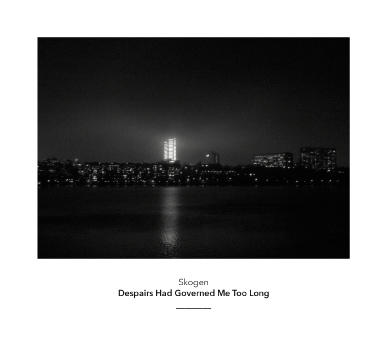
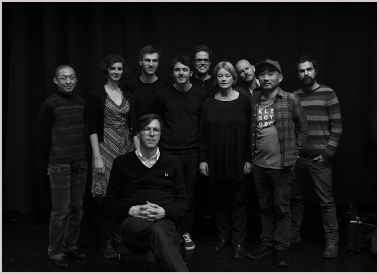
Original cover for ‘Despairs had Governed Me Too Long’ (2012)
Skogen with Magnus Granberg
Interview with Magnus Granberg by Javier Santafé on the release of ‘Despairs Had Governed Me Too Long’ (2012)
JS: If I had to explain your music to a friend here in Spain, how should I describe
it? Improv, modern composition, EAI, comprovisation....
MG: Well, I guess you would
know your friend and his or her previous knowledge about music better than I would,
so in that respect I think you would be better suited than I to explain it! But the
highly specialized categories that you mention imply that your friend would be quite
well acquainted with various branches of contemporary music, and if so I guess that
you could say that the music, among many, many other things, is to a certain extent
informed by certain musics within all of these categories. But the original idea
was, on the one hand, to create a space where there's room for many different ways
of working and existing as a musician and a human being, and on the other hand, to
try to integrate these ways of working, to create a music and performance practice
which draws no clear distinction between such categories as composition and improvisation.
JS: All three of your discs for Another Timbre were recorded in two sessions on Nov
10 and Nov 12.The music on the three CDs is not very different and easily recognisable
as Skogen. Are you creating a "musical style of your own", based on an iteration
piano, strings, percussions and electronics subtly played?
MG: Well, the discs were
all recorded in November, that's true, but our first release on Another Timbre (Ist
gefallen in den Schnee) was recorded in November 2010, and the last two were recorded
on the same day in November 2012. Our second album on AT is a recording of a piece
by Anders Dahl called Rows, whereas the first and third records contain pieces of
my own. The instrumentation on all three records is more or less identical, and I
guess that instrumentation, timbre, and the general dynamic level and performance
practice within the ensemble all definitely contribute to the perception of a certain
similarity, even though I don't think that these aspects of the music necessarily
set it too much apart from other musics in this field. When it comes to my pieces,
I think that other stylistic traits such as tonal and rhythmic modality, as well
as certain rules governing the intervallic structures of the chords and the melodic
fragments, might be equally important as instrumentation and dynamics when it comes
to making the music stylistically concise and easily identifiable.
JS: I generally don’t like music played by large ensembles. I always feel that with
“many hands in the kitchen”, there’s no room for everybody’s sounds. But Skogen is
an exception. It never sounds like there are so many players. What is your secret?
MG:
I guess one reason the music doesn't come across as being cluttered (though I guess
for some people it still very well might!) is the simple fact that the density of
musical events is comparatively low. I myself am very fond of the idea and practice
in, for example, Javanese gamelan music, where some of the musicians, depending on
their instrument, may just play one, two or perhaps four strokes during musical cycles
which sometimes may last for several minutes. Japanese Gagaku music is another East
Asian orchestral tradition which partly works in a similar way, I think. Other reasons
may perhaps be found in the instrumentation (which is predominantly made up of decaying
sounds) or the way the acoustic material is distributed throughout the tonal spectrum.
And, if I may say, the sensible and intelligent musicality of the players, of course!
JS: In the last 20 years, improvised music has created its own path, far away from
jazz, and it has been in constant evolution. Where do you see this music in 2020?
MG:
Yes, the development of improvised music from, say, the mid 90s onwards was quite
expansive. Though I do think that in the last eight to ten years or so we have seen
improvised music going through stages of consolidation, and some people might even
say stagnation. On the other hand I think that during the last decade we’ve also
have seen an increased mixing or breaking up of disciplines within the general field
of contemporary music, for example how improvisers have teamed up with composers
and interpreters of what one might call the post-Cage or Feldman continuum, or how
improvisation has become an important element in certain artistic practices otherwise
quite closely related to electro-acoustic composition, musique concrète or text-sound
composition. Methods and materials associated with certain disciplines are combined
in different ways than before, I think. And I guess these two tendencies, consolidation
and classicism on the one hand, and a continuing breaking up, mixing and reassembling
of methods and materials from different musical traditions on the other hand, might
be something we will still hear a few years from now. And hopefully some surprising
new input as well!
JS: The last track on “Rows”, which is one of the last tracks recorded by the group,
is quite different to the rest of your music. Sparse strings over “white noise”,
no piano... in my opinion a beautiful way to end the CD. Could that be a new path
for Skogen in the future?
MG: Well, that piece is of course Anders Dahl's piece, and
a very beautiful one indeed. I think there is a little section on our new record
which shares a similar instrumentation as the one you mention. But yes, that is actually
one of many possibilities that could be interesting to explore further!
JS: Would you consider recording a solo piano CD? Or an all acoustic “small group”,
without electronics?
MG: I've never thought about recording a CD of solo piano music,
actually! But it would be an interesting challenge, I think. I'll definitely take
it into consideration! But I do have plans to record a couple of pieces for a somewhat
smaller, all acoustic setting later on this year. I'm very much looking forward to
it!
JS: Which music or musicians do you listen to at home?
MG: I listen to quite a lot
of music at home actually, and I tend to go through periods where I listen quite
intensely to specific musics. Earlier this year for example, I was listening a lot
to recordings by Indian rudra veena players such as Asad Ali Khan and Zia Mohiuddin
Dagar and his son, Bahauddin Dagar. I also recently had a period where I listened
intensely to Sun Ra's early recordings, things from the mid to late fifties. And
last month I've actually listened to a lot of piano music: Bach's keyboard music
performed by Rosalyn Tureck, Tim Parkinson's piano music performed by Philip Thomas,
and a very beautiful recording of Aldo Clementi's music for one or two pianos performed
by Mats Persson and Kristine Scholz. Captivating, inspiring and truly wonderful music!
